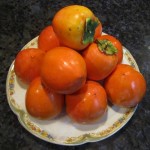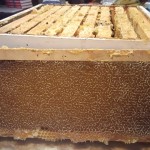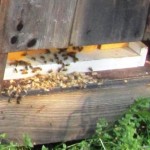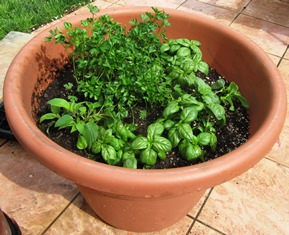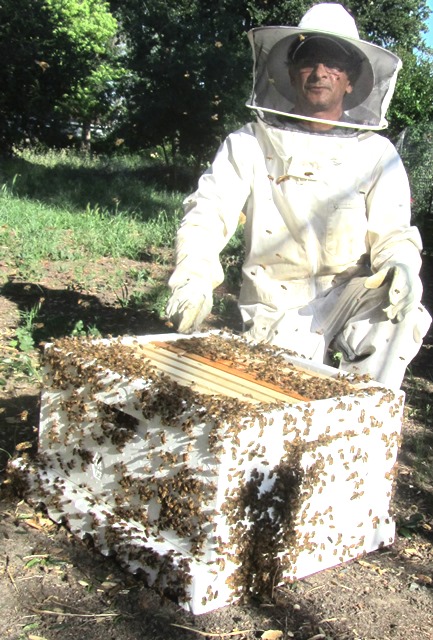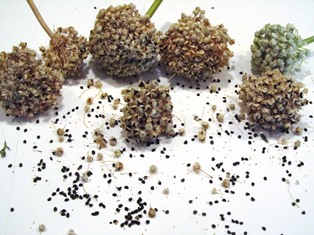Gardening Isn’t Fun When the Air Quality is Foul
I awoke today intending to collect some persimmons and gather in the ripe pomegranates from my garden But the news on my local TV station made me think twice about going outside to work.
The Bay Area air quality would be four times as bad as in Beijing (where many wear masks to avoid breathing the particulate). I’ve lived in the Bay Area since the 1970s and can’t remember suffering through such terrible air quality. Gardening was out of the question.
Our Bay Area air is so awful because of the “Camp Wildfire” that recently broke out up north. The inferno stoked by high winds was so fast-moving that it pretty much destroyed the town of Paradise (near Chico). Those winds also swept the smoke southward into the Bay Area. Although I live spitting distance from Mount Diablo, I couldn’t even see the mountain yesterday or today.
What I could see was a blood-red ball hanging in an opaque sky. Never saw the sun look like that.
Not only are wildfires raging on in Northern California. With Southern California’s Woolsey fire threatening Malibu and a section of nearby Thousand Oaks, I worry about family and friends in SoCal. Also, I am praying for those affected by the recent Thousand Oaks mass shooting. Not only are those folks grief-stricken, they now have to evacuate as fire threatens their community.
The rainy season in Northern California runs from November to April, but unseasonably warm weather (in the 80s F. last week and 70s F. this week) has been the norm. Fire danger remains high until the rains come.
I hope firefighters in our Golden State and everywhere else know how much their work and sacrifices are deeply appreciated.
The smell of smoke outside is overwhelming. So while nothing gives me greater pleasure than being outside working in my garden, I won’t today. Not when I can’t breathe.
_______________________________________________________________________
From here on the Henny Penny Farmette, I write nonfiction self-help books about health, wellness, and spirituality; and for fiction, I write mysteries that incorporate aspects of farmette life like keeping chickens and honeybees and growing heirloom fruits and vegetables.
Find all my books at Amazon.com, through Barnes and Noble, at Kobo Books, and elsewhere online or in traditional bookstores everywhere.

More than 150 rituals for sound mind, strong body, and meaningful connections to the people around you
De-Bugging My Honeybee Hive Box of Beetles
I’ve been dealing with a beetle problem in my honeybee hive since fall. When my knowledgeable beekeeper neighbor called to suggest opening the hive, I readily agreed.
The dreaded hive beetle–tinier than a honeybee–can destroy a hive. Its destruction isn’t on the bees themselves, but rather the comb, honey, and pollen. As the population of hive beetle increases and the destruction mounts, the bees will abandon the hive.
Previously, my neighbor had used two types of hive beetle traps in my hive–Beetle Bee-Gone was an all-natural, chemical-free sheet that looked like a fabric softener product for the dryer. We had placed this on top of the frames before closing the hive last fall. The other product was a narrow plastic tray inserted between the frames that held vegetable oil.
We discovered that the sheet worked well, trapping lots of hive beetles. But the frame with oil had no beetles. I dumped it. We checked the brood box–and were excited to see it full of unborn babies.
After harvesting eight frames of honey, we reversed the brood box, scraped away the burr comb, and positioned a super on top of the hive box with empty frames for spring honey. Before closing the hive, we inserted two clean sheets of Beetle Bee-Gone.
Today, the bees are active and out foraging for pollen. Flowers are everywhere and the fruit trees in the neighborhood have broken bud. It remains to be seen if the Bay Area gets any more rain or bitterly cold days ahead. Probably by April 1, I’ll hang the swarm catcher and hope to add a new population of bees to my colony.
______________________________________________________________________________
If you enjoy reading about keeping bees, growing heirloom vegetables and fruits, caring for chickens, or self care for healthy living, check out my Henny Penny Farmette series of cozy mysteries: A BEELINE TO MURDER, THE MURDER OF A QUEEN BEE, and HIVE OF HOMICIDES. Click on the URL below. Also see newest nonfiction for healthy living: RITUALS FOR LIFE.
http://tinyurl.com/ya5vhhpm
Heirloom Herbs for the Kitchen
The green stalks of the red and yellow onions I planted in late summer are now up about a foot in a raised bed. The garlic that I planted around the same time is also poking up. Having onions, garlic, and fresh culinary herbs available year-round is not impossible in the Bay Area’s mild climate, especially when they are grown in cold frames, protected areas, and raised beds.
Some will re-seed themselves in the growing beds or around your yards. We’ve got Greek oregano and chives growing all over the place. Some of my favorites herbs include basil, cilantro, chervil, chives, dill, fennel, lemon balm, lavender, oregano, mint, marjoram, rosemary, thyme, parsley, sage, and savory.
We also grow a few ornamental herbs such as borage, hyssop, and catnip (for our new kitty), tea herbs (chamomile and mint), and medicinal herbs (like echinacea).
Herbs are easy to grow. Their blooms will attract insects beneficial to the garden. Butterflies and hummingbirds are also attracted. And herbs don’t need much–light, and porous soil, warmth, and decent drainage. For a light feeding of the herbs, we make chicken poop tea. With so many varieties of herbs available, why not tuck a few in your garden or in containers in a protected but sunny and warm area of your patio to enjoy in your culinary creations?
Killer Bees Found for the First Time in the East Bay
Global warming might be responsible for our extreme summer heat and the multi-year drought in the Bay Area. It might also explain the presence of killer bees, too. For the first time, U.C. San Diego scientists tracking the Africanized honeybees have found them here in the East Bay city of Lafayette.
The Oakland Tribune suggests the Africanized honeybees are docile unless their hive is threatened. Otherwise, the Africanized or “killer bees” are of similar temperament and have a similar sting as the European honeybees. See, http://www.insidebayarea.com/breaking-news/ci_28892198/killer-bees-detected-lafayette-bay-area-first-time?source=rss
The Africanized bees were bred with European honeybees in Brazil in 1956 to produce a honeybee better suited to Brazil’s climate. The bees escaped their containment, bred with European bees and spread.
The Africanized bees breeding with European honeybees quite possibly means the resulting bees may have a stronger resistance to one of diseases believed responsible for European bee die-offs and colony collapse disorder.
Widely published stories today tell us that the killer bees have been detected in Briones Regional Park in Lafayette, only ten miles from where I keep bees on the Henny Penny Farmette.
Researchers from U. C. San Diego have tracked the bees throughout the state. Likely more than one colony has been established here. But whether or not the bees stay remains to be seen. See, http://www.sfgate.com/bayarea/article/Killer-bees-found-in-the-Bay-Area-for-the-6535892.php
Bees prefer warmer, drier habitats, so they may not stick around. The strong El Nino forecast for this winter could bring much needed rain to the Bay Area and plunging temperatures to the freezing mark.
Africanized bees swarm relentlessly when they perceive a threat. If you are out walking and notice bees foraging on wildflowers, become vigilant. They may not bother you. But do observed them. Don’t swat at them, it will antagonize the bees.
If they start moving toward you, run to at least 100 yards away. Retreat indoors if possible. Don’t think you can escape by jumping into a lake or pool. Researchers say the killer bees have been known to wait above the water.
To read an in-depth analysis of the Africanized honeybee, see http://www.library.ca.gov/crb/99/notes/v6n2.pdf.
To curl up with a cozy mystery that features gentle honeybees, check out my newest novel, A BEELINE TO MURDER: http://www.amazon.com/s/ref=nb_sb_noss?url=search-alias%3Dstripbooks&field-keywords=Meera+Lester&x=0&y=0
A Drought Is No Way to Dry Onions
With water use restricted in many counties because of the terrible drought, my garden is withering. Everyone in the Bay Area has to do their part. My onions look particularly pathetic.
In July, I polished a mystery I had hoped to sell. Mid-month, BEELINE TO MURDER sold to Kensington Publishing in New York as the first in a three-book deal. That meant I had to get cracking on the second book.
I forgot the onions. Poor things. The tops fell over and wilted, the bottoms swelled and stopped. A few succumbed to the soil organisms and bugs.
August rolled around and I looked over the patch of brown stems and the heads that had gone to seed and vowed to dig everything out. But then . . . I got an offer to write a short nonfiction book that tied into the Law of Attraction, one of my favorite subjects. The onions had to wait for another 20 days until I cranked out that project.
Yesterday, my husband harvested the onions. Some have to be tossed because of bottom rot. Anything ignored will wither and die–that’s an axiom of gardening I’ve known since forever. So, the onions are gone, but their seeds are plentiful (thousands), so this fall I will plant a new crop of onions and another in the spring and pray for rain.
Little Foxes on my Front Porch
The heat drove me from bed this morning around 6 a.m. Northern California is in the midst of a triple-digit heat wave and there’s not much relief at night.
I made coffee, as I always do as soon after rising, and peeked out the back sliding glass door. I can see into the chicken house because my husband installed windows. The chickens were still on the roost. I’d have time for a swallow or two of coffee.
Then I heard what sounded like a knock at the front door. Padding across the living room in bare feet, I opened it, half expecting to see my daughter (also an early riser; she likes making runs to Starbucks for her coffee).
It wasn’t my daughter. It was a small fox. The poor thing seemed as startled to see me as I was to see it.
When the fox bounded off the porch, I saw the other two. Yes, there were three–a whole family–in my front yard. Perhaps they came down from the hills of Mount Diablo to search for water or food . . . so back to the chickens I went.
Certain that there was no way for the foxes to get into the chicken run, I let the hens out; gave them food and water. Then, after searching the property for those little foxes, I went back to enjoy my coffee while the sun rose to begin roasting the Bay Area.
 Facebook
Facebook Goodreads
Goodreads LinkedIn
LinkedIn Meera Lester
Meera Lester Twitter
Twitter



